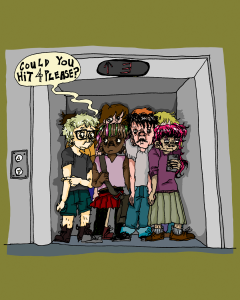OPINION: Stress culture shouldn’t be normalized
November 29, 2022
It’s no secret that students across the nation deal with a huge amount of stress on a daily basis. According to Psychology Today, the average high school student has similar levels of anxiety as mental patients during the 1950s, a problem the COVID-19 pandemic has only worsened. Much of this anxiety results from the pressure that students feel when it comes to academics and schoolwork, which begs the question: what are schools doing, or not doing, to help combat these dangerous levels of stress in their student populations?
First, it is important to understand where exactly the problem lies. In a 2019 study by the American College Health Association, which surveyed just under 70,000 students across 98 different colleges around the United States, over 50% of students reported that they felt their academic endeavors were “traumatic or very difficult to handle,” with the same sample population also having more than 50% of students feeling “hopeless,” “overwhelmed” and having experienced “overwhelming anxiety.” These results display a clear correlation between feelings of anxiety and depression, and the feeling of being overwhelmed by academic work, a correlation which exists across the entire country. Yet, for as glaring of a problem this is, it’s surprising that this culture of stress has essentially been normalized throughout the college experience.
When putting the words “college student” into Google images, an interesting trend emerges among the immediate results. Many images show students working in libraries, coffee set to the side, studying late into the night with hands on their foreheads clearly in some kind of distress. These images are the common stereotype for the average college student, people who are stressed out, forced to give up their sleep and free time in order to finish assignments, all as a part of the “college experience.”
That’s not even counting the massive student debt crisis that looms over many college students, which itself has almost become synonymous with the “college experience.” That isn’t to say that the college experience isn’t positive whatsoever, but notice how many of the more positively romanticized aspects of college — partying, making friends, dating, etc. — aren’t related to the academic aspects of higher education, which singles out the workload in college as being the primary source of stress for modern college students.
With a problem as large as this, it comes as no surprise that many different solutions have been instituted across several different universities, with varying degrees of success. The first idea that many schools in America have tried out is the idea of instituting mental health days. Several states have allowed for students to take a day off from school for mental health-related reasons, in the same way that one would take a day off due to sickness.
While mental health days are a good start to addressing the problem of stress culture, it isn’t a concrete solution, as student Ashley Wallace from Northeastern University says “My two wellness days are gonna be spent doing work that’s due as soon as we get back from the wellness day.” Another solution posed by some schools is instituting proper mental health training among the faculty, allowing professors to spot potential red flags in students and help them on a level that would help them tremendously; if a student can ask for an assignment extension, teachers could offer them to students as well in order to help reduce stress that the class may be causing.
A third solution could be peer-to-peer counseling for those students who may be wary of going to proper counseling provided by the university, and would instead feel more comfortable talking to a friend or fellow student in a safe and comfortable environment about the issue at hand.
The bottom line is this: there may not be a one size fits all solution to the problem of stress culture and student mental health in college settings, but any action is better than no action. Taking small steps to help students know that they have the resources to combat anxiety and depression while simultaneously giving them the tools they need to do so is the only way that, slowly but surely, the overwhelming culture of stress that exists in collegiate America can be dealt with. So many students need help with these kinds of issues, and the longer they go without getting it, the worse the problems become.












